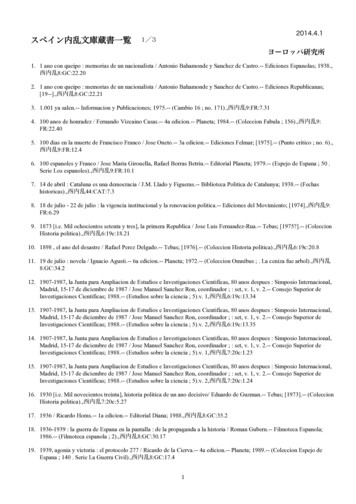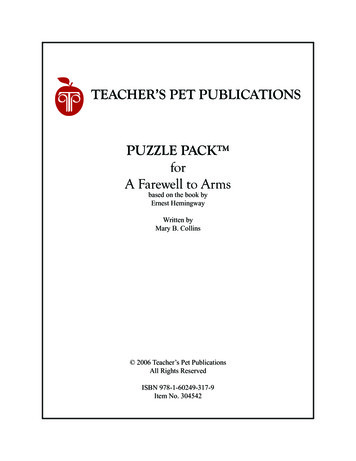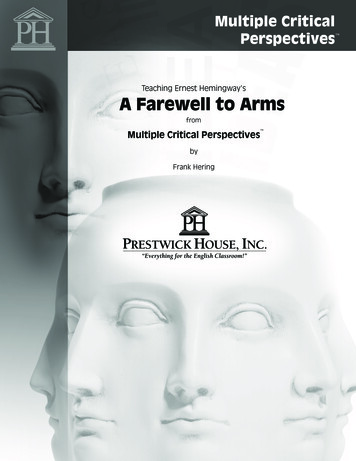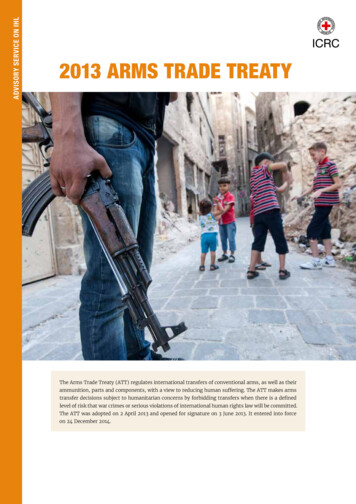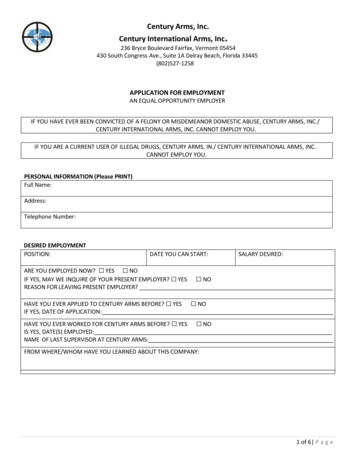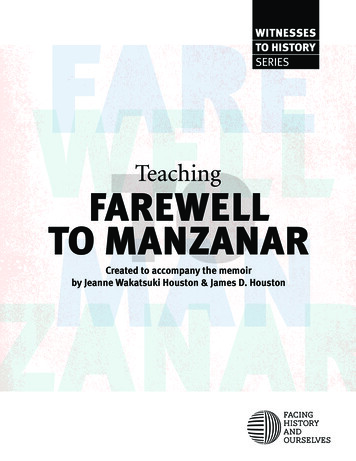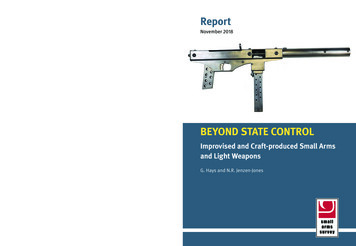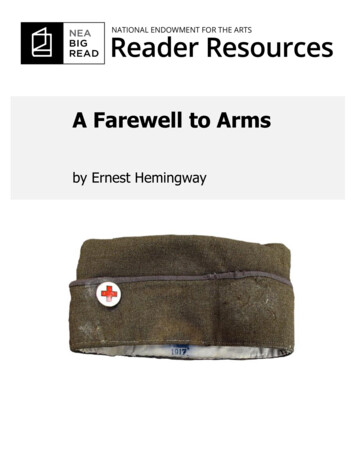
Transcription
A Farewell to Armsby Ernest Hemingway1
Table of ContentsA Farewellto ArmsAbout the Book. 3About the Author . 4Historical and Literary Context . 6Other Works/Adaptations . 8Discussion Questions. 10Additional Resources . 11Credits . 12PrefaceErnest Hemingway is the notorious tough guy of modernAmerican letters, but it would be hard to find a more tenderand rapturous love story than A Farewell to Arms. It wouldalso be hard to find a more harrowing American novel aboutWorld War I. Hemingway masterfully interweaves these dualnarratives of love and war, joy and terror, and—ultimately—liberation and death.It will surprise no one that a book so vivid and deeply feltoriginated in the author's own life. Hemingway served as anambulance driver for the Italian army in World War I.Severely wounded, he recuperated in a Red Cross hospital inMilan where he fell in love with one of his nurses. Thisrelationship proved the model for Frederic and Catherine'stragic romance in A Farewell to Arms.“All good books arealike in that they aretruer than if theyhad really happenedand after you arefinished reading oneyou will feel that allthat happened toyou and afterwardsit all belongs toyou.”What is the NEA Big Read?A program of the National Endowment for the Arts, NEA BigRead broadens our understanding of our world, ourcommunities, and ourselves through the joy of sharing agood book. Managed by Arts Midwest, this initiative offersgrants to support innovative community reading programsdesigned around a single book.A great book combines enrichment with enchantment. Itawakens our imagination and enlarges our humanity. It canoffer harrowing insights that somehow console and comfortus. Whether you’re a regular reader already or making upfor lost time, thank you for joining the NEA Big Read.NEA Big ReadThe National Endowment for the Arts2
About the BookIntroduction tothe Bookmost widely imitated American writer of the twentiethcentury.Ernest Hemingway's thirdnovel, A Farewell to Arms(1929), was crafted from hisearliest experience with war.As a teenager just out of highschool, Hemingwayvolunteered to fight in theFirst World War but wasrejected because of pooreyesight. Instead, he drove aRed Cross ambulance on theItalian front, where he waswounded in 1918 by a mortarshell. While recovering in a hospital, Hemingway fell in lovewith Agnes von Kurowsky, a nurse seven years his senior.She did not reciprocate his passion, however, and rejectedhis marriage proposal five months after their first meeting.These events were thinly fictionalized by Hemingway adecade later into A Farewell to Arms, with its tragic lovestory between an American ambulance driver and an Englishnurse. Lieutenant Frederic Henry meets Catherine Barkley ina small town near the Italian Alps. Though Catherine stillmourns the death of her fiancé, killed in the war, sheencourages Frederic to pursue her. Badly wounded at thefront, Frederic finds himself bedridden in a Milan hospital,but Catherine arrives to look after him. It is here that theirinitial romance deepens into love. While Frederic recoversfrom surgery and prepares to return to action, Catherinediscovers that she is pregnant—a surprise that delights andfrightens them both. Though the couple has escaped thewar, there are dangers that cannot be anticipated oravoided. The final chapter is one of the most famous, andheartbreaking, conclusions in modern literature.This rather simple plot does not explain the appeal of AFarewell to Arms. It is Hemingway's writing style thattransforms the story into a great tragedy. The critic MalcolmCowley considered it "one of the few great war stories inAmerican literature; only The Red Badge of Courage and afew short pieces by Ambrose Bierce can be compared withit." By omitting most adjectives and using short, rhythmicsentences, Hemingway tried to give the reader a sense ofimmediacy, of actually witnessing the events in his writing.He once described his method this way: "I always try towrite on the principle of the iceberg. There is seven-eighthsof it under water for every part that shows. Anything youknow you can eliminate and it only strengthens youriceberg." His spare prose and laconic dialogue made him theNEA Big ReadThe National Endowment for the Arts3
About the AuthorErnest Hemingway(1899-1961)Ernest Hemingway may havebeen the most famous novelistin the English language duringhis lifetime. Idolized by readers,envied by fellow writers, andadored by many for theromantic lifestyle that hecreated for himself, Hemingwaythe writer must always bedistinguished from Hemingwaythe public figure. The first wasErnest Hemingway in Paris,1928 (The John F. Kennedya sensitive and exacting artist;Presidential Library andthe second was a larger-thanMuseum, Boston)life image maintained fortabloid consumption. As early as 1929, Dorothy Parker wasmoved to remark: "Probably of no other living man has somuch tripe been penned or spoken."The adulation that Hemingway inspired is not difficult toexplain. By turns tough and tender, he lived a life ofexuberant masculinity—which included hunting for big gamein Africa, for Nazi submarines in his fishing boat off KeyWest, or for the best bar in Paris. He celebrated bullfighting,boxing, hunting, and even warfare as manly pursuits worthyof respect. His years were rife with adventurous accident,including an anthrax infection while on honeymoon inFrance, and two successive plane crashes on safari. Seconddegree burns resulting from a bushfire accident preventedhim from traveling to Sweden to accept the Nobel Prize. Hewon the Silver Medal of Military Honor in the First World Warand the Bronze Star Medal in the Second. A leader of the socalled "Lost Generation" and a Modernist, Hemingway'sclosest friendships included literary giants Ezra Pound,Gertrude Stein, and James Joyce. He was an intellectual anda celebrity, and one of the few Americans to find both rolescongenial. He married four times and lived to see eighteenof his works published. He died a millionaire, a close friendof movie stars such as Gary Cooper, and a winner of boththe Pulitzer and Nobel prizes. In many ways, his career wasthe stuff of legends.Such success did not, however, alleviate his personalstruggles. For a man so publicly celebrated and revered, hecould be curiously reticent—he wanted no biography writtenabout his life, and he left a will that blocked any publicationof his letters. His later years were marked by severedepression, for which he underwent electro-convulsivetherapy. Suffering from acute paranoia, he believed for atime that federal agents were after him. Years of alcoholismNEA Big ReadThe National Endowment for the Artsand organ damage wreaked havoc on his body; digestivecomplications, high blood pressure, and failing eyesighttroubled him constantly. Ernest Hemingway eventuallycommitted suicide in 1961, following the path of his fatherand two siblings.Hemingway and the LostGenerationThough he had served as an ambulance driver during theFirst World War, Ernest Hemingway's decisive years inEurope started in 1921, when he arrived in France with aletter of introduction from the writer Sherwood Anderson. Inthose postwar years, Paris had become the home of manyexpatriate writers, including Ezra Pound, James Joyce, E. E.Cummings, Ford Madox Ford, and Gertrude Stein. HartCrane and F. Scott Fitzgerald were frequent visitors. It wasthis circle of mostly American writers that Hemingway joinedwhen he arrived; and while "the Lost Generation" wasGertrude Stein's phrase, it was Hemingway whoimmortalized it in the epigraph for his 1926 novel, The SunAlso Rises. The book was so popular that, by 1934, MalcolmCowley could note, "It was a good novel and became acraze—young men tried to get as imperturbably drunk as thehero, young women of good families took a succession oflovers in the same heartbroken fashion as the heroine, theyall talked like Hemingway characters and the name wasfixed."Recently married and employed as a foreign correspondentfor the Toronto Star newspaper, Hemingway spent his daysinterviewing leaders such as Mussolini and writing fiction. Hesoon became Ford's assistant editor at The TransatlanticReview, an important literary magazine. In 1923, theAmerican author and publisher Robert McAlmon printedHemingway's first book, Three Stories and Ten Poems, inParis. Hemingway would later complain that all he earnedfrom this book "was the enmity of McAlmon, because it soldout while his own volumes remained in stock."Another American, Sylvia Beach, opened a bookshop calledShakespeare & Company in 1919, and it soon became acenter of literary life in Paris. The store even loaned itspoorer patrons rare books, such as D. H. Lawrence's bannedLady Chatterley's Lover It was shut down in 1941supposedly because Beach would not allow a German officerto buy the last copy of James Joyce's Finnegans Wake ;Beach had been the first to print Joyce's Ulysses in 1922.Why were so many American writers living abroad? Pariswas a cheap place after the war, with none of the stricturesto be found back home, such as Prohibition. Daringinnovators in all the arts lived there—like Picasso, Stravinsky,4
and Modigliani—and many were neighbors in the cheapdistricts of Montparnasse. The artistic and intellectualferment of those years moved Hemingway to write: "If youare lucky enough to have lived in Paris as a young man,then wherever you go for the rest of your life, it stays withyou, for Paris is a moveable feast.""Every man becomes civilized between the ages of eighteenand twenty-five. If he does not go through a civilizingexperience at that time of his life, he will not become acivilized man. The men who went to war at eighteen missedthe civilizing . All you young people who served in the warare a lost generation. You have no respect for anything."—Gertrude SteinNEA Big ReadThe National Endowment for the Arts5
Historical and Literary ContextThe Life and Timesof Ernest Hemingway1950s 1952: The Old Man and the Sea published. 1954: Hemingway awarded the Nobel Prize forLiterature.1890s 1899: Ernest Miller Hemingway is born on July 21 inOak Park, Illinois.1910s Gen. Charles de Gaulle becomes French premier in1957, and remains in power until 1969.1960s 1960: John F. Kennedy elected president. 1912: Woodrow Wilson is elected president. 1914: World War I begins, ends in 1918. 1918: Hemingway serves as an ambulance driver; heis wounded in July. 1961: U.S. breaks diplomatic relations with Cuba.Hemingway commits suicide in Ketchum, Idaho, onJuly 2. 1964: A Moveable Feast edited by Hemingway's fourthwife and published.1920s 1920: Prohibition goes into effect on January 16.Hemingway and World War I 1921: Hemingway marries Hadley Richardson, andmoves to Paris.When the United States declared war on Germany andentered World War I in April 1917, the fighting in Europehad been going on for three years. America joined the Allies,led by France, England, Russia, and Italy, who had beenfighting Germany, Austria-Hungary, and the Ottoman Empire(Turkey). Antiquated nineteenth-century battlefield tacticscombined with the innovations of modern warfare led to amonumental loss of life. At the Battle of the Somme in July1916, British forces launched a relentless barrage ofordnance on German trenches that lasted six days. Britishsoldiers were quickly killed by machine gun and rifle fire. Bythe time the battle ended, Britain had suffered 400,000casualties; the French 200,000; and 450,000 Germans alsolay dead in what was one of the bloodiest battles ever. 1922: James Joyce's Ulysses published in Paris. 1929: A Farewell to Arms published; Hemingway'sfather commits suicide.1930s Hemingway's two memoirs, Death in the Afternoonand Green Hills of Africa, published, 1932 and 1935. 1933: Adolf Hitler becomes chancellor of Germany. 1937-38: Hemingway travels as a war correspondentto the Spanish Civil War.1940s 1940: The first inexpensive paperback appears; ForWhom the Bell Tolls published. 1941: Japanese forces bomb Pearl Harbor; Americaenters World War II. Hemingway travels with American troops as acorrespondent.NEA Big ReadThe National Endowment for the ArtsBy 1917, however, such atrocities had not touched America.Heeding President Wilson's admonition to "make the worldsafe for Democracy," young American boys enlisted indroves. While the public could "Beat Back the Hun withLiberty Bonds," these young men saw a chance to be a partof history—the "War to End All Wars."Ernest Hemingway was determined to be part of the action,but an eye defect kept him out of the main branches of themilitary. Hemingway was undaunted. In April 1918 heapplied to the Red Cross to drive ambulances in Italy andwas accepted. He passed his physical exam and was fittedfor a uniform that gave him the honorary rank of 1stLieutenant.6
Hemingway arrived in Milan in early June and was stationedat Schio in the Dolomite hills northwest of Venice. He sawlittle action. Frustrated, and with a desire to be closer to thefront, Hemingway requested transfer to the Red Cross's"rolling canteen" service, which operated along the morecontested Piave River.He had only been in Italy for about two weeks when he wasnearly killed just after midnight on July 12, 1918, whiledistributing chocolate and cigarettes. The fragments of anAustrian trench mortar shell (called a Minenwerfer) rippedinto Hemingway's legs and killed several men around him.Despite his own wounds, he heaved one injured man into afireman's carry and began to move him back toward thecommand post. A machine gun then ripped openHemingway's right knee. The two men collapsed butsomehow made it to safety. For this feat, Hemingway wouldlater be awarded the Italian Croce di Guerra—the silvermedal for valor.NEA Big ReadThe National Endowment for the Arts7
Other Works/AdaptationsHemingway and His Other WorksHemingway at the MoviesThe works of Ernest Hemingway have a long and variedpublication history. Some have disappeared, like the stolenearly stories that his first wife mislaid; others are ignored,like his first novel, The Torrents of Spring (1926), and hisonly play, The Fifth Column (1938). Several novels anddozens of short stories are considered classics—and thoughHemingway died in 1961, works bearing his name haveappeared as recently as 1999.A Farewell to Arms was made into a movie twice: the 1932Only 300 copies of Hemingway's first book, Three Storiesand Ten Poems (1923), were printed in Paris. The shortstory collection In Our Time (1925) cemented Hemingway'sreputation as one of the finest American writers alive.F. Scott Fitzgerald convinced Hemingway that he shoulddump his current publisher and sign with Scribner, whereMaxwell Perkins (who also worked with Fitzgerald andThomas Wolfe) would serve as his editor. In order to do so,Hemingway needed to write an "unpublishable" book tobreak his three-book contract. So, he wrote The Torrents ofSpring (1926) in ten days; it arrived in the same year as hisclassic The Sun Also Rises.In 1929, A Farewell to Arms became Hemingway's firstbestseller, selling 100,000 copies in twelve months. It wasadapted for the stage a year later and has been made into afilm twice. The same year that he divorced his first wife, hepublished more stories in Men Without Women (1927). Thebullfighting memoir Death in the Afternoon (1932) wasfollowed by the safari hunting memoir Green Hills of Africa(1935).By now, Hemingway had established a pattern—eachmediocre book was followed by a masterpiece. His novel ToHave and Have Not (1937) is as neglected today as ForWhom the Bell Tolls (1940) is celebrated. Across the Riverand Into the Trees (1950) had critics calling him a hasbeen—a charge they had to retract when The Old Man andthe Sea (1952) won the Pulitzer Prize.After his death, Hemingway's unfinished manuscriptscontinued to appear for many years—most notably the Parismemoir A Moveable Feast (1964), and the two novelsIslands in the Stream (1970) and The Garden of Eden(1986). His Selected Letters appeared in 1981, followed bythe Complete Short Stories in 1987; while True at First Light,billed as Hemingway's last posthumous work, was edited byhis son Patrick and released to commemorate his 100thbirthday in 1999.NEA Big ReadThe National Endowment for the Artsadaptation, starring Gary Cooper and Helen Hayes, isgenerally considered superior to the 1957 extravaganza withRock Hudson and Jennifer Jones in the lead roles. The lattermovie should have been a great success—directed by thelegendary John Huston, it was to be the last film producedby David O. Selznick, who had made Gone with the Wind.However, Selznick replaced Huston with Charles Vidor midpicture, after the pair clashed over the sentimental directionthat Selznick wanted. It was not an inspired substitution.With Hudson and Jones overacting in every scene, the filmcan be hard to watch.The 1932 version, directed by Frank Borzage, is better—andhalf as long. It won an Oscar for Charles Lang's gorgeousblack-and-white cinematography. Gary Cooper, who playedthe lead role both here and in For Whom the Bell Tolls(1943), became for many people the personification ofHemingway's heroes. The scenes in A Farewell to Arms withCooper and Helen Hayes are intense (Hayes reportedly fell inlove with her co-star on the set), and the film has a starkand brooding energy. The movie is not, however, entirelyfaithful to the book. Worried that audiences would dislike thegrim ending, Paramount Pictures ordered that an alternate,upbeat finale be added. Hemingway was hardly thrilled withthe result.There are plenty of other Hemingway books to savor onscreen. One of the best is Howard Hawks's To Have andHave Not (1944), which sizzles with the chemistry betweenHumphrey Bogart and Lauren Bacall (who also fell in love onthe set). With a screenplay co-written by the great novelistWilliam Faulkner, the film is considered a classic—includingsome of the most memorable dialogue ever written. Themovie's plot hardly resembles the book, but thenHemingway supposedly made a bet with Hawks that thedirector would find the novel impossible to film.Another great movie is Robert Siodmak's The Killers (1946),a film noir starring Burt Lancaster (in his debut) and AvaGardner. Based on one of Hemingway's short stories, TheKillers is the tale of a duped ex-boxer who turns into a crookand then a victim for the sake of a dangerous woman.Nominated for four Academy Awards, the film made AvaGardner a movie star and a sex symbol almost overnight.Reportedly, this was Hemingway's favorite movie made fromhis work.Other Hemingway-inspired films include John Sturges's TheOld Man and the Sea (1958) with a grizzled Spencer Tracyas the lonely fisherman. And good luck finding a copy of TheSun Also Rises (1957). Despite its all-star cast with Tyrone8
Power, Errol Flynn, and Ava Gardner, it has never beenreleased on video or DVD.Selected Works by Hemingway In Our Time, 1925 (stories) The Sun Also Rises, 1926 (novel) A Farewell to Arms, 1929 (novel) Death in the Afternoon, 1932 (non-fiction) Green Hills of Africa, 1935 (non-fiction) For Whom the Bell Tolls, 1940 (novel) The Old Man and the Sea, 1952 (novel) A Moveable Feast, 1964 (non-fiction) Islands in the Stream, 1970 (novel)NEA Big ReadThe National Endowment for the Arts9
Discussion Questions1.What do we know of Frederic Henry's and CatherineBarkley's lives before the novel begins? As thenovel's narrator, why would Frederic choose to tellus so little about their past?2.At the beginning of their romance, Frederic treatshis relationship with Catherine like a game. Whendoes he fall in love? Why does it happen?3.What role does religion play in the novel? How doesFrederic's view of the priest compare to the otherofficers'?4.Why is Catherine afraid of the rain? Why doesFrederic fear the night? How do both the rain andthe night foreshadow the novel's tragic conclusion?5.Even before the retreat at Caporetto, Fredericconsiders that "abstract words such as glory, honor,courage" are "obscene beside the concrete namesof villages." What does he mean by this?6.Identify a passage that vividly describes World WarI. Does the novel make any assertions about war ingeneral, or World War I in particular?7.After his desertion, Frederic says that, "anger waswashed away in the river along with any obligation."Are his actions justified?8.The novel's action begins in the late summer of1915; it ends in spring 1918. Has Frederic changedduring this period of time? Is there any redemptionat the end of this tragedy?9.Toward the end of the novel, Count Greffi tellsFrederic that love is a religious feeling. DoesFrederic agree? Why or why not?10. How would you describe Hemingway's style ofwriting and his characters' dialogue?11. The words "bravery" and "courage" are echoedthrough the novel. Who is the novel's hero? Who isthe most courageous character?NEA Big ReadThe National Endowment for the Arts10
Additional ResourcesResources on Hemingway and theLost Generation Bruccoli, Matthew J. Fitzgerald and Hemingway: ADangerous Friendship. New York: Carroll & Graf,1994. Hemingway, Ernest, and Carlos Baker, ed. ErnestHemingway Selected Letters: 1917-1961. New York:Scribner, 2003. Hemingway, Ernest, and Larry W. Phillips, ed.Ernest Hemingway on Writing. New York: Scribner,1984. Reynolds, Michael. Hemingway: The Paris Years.New York: Norton, 1989.Websites The Hemingway SocietyThe Hemingway Society was established in 1965 byMary Hemingway, Ernest's widow. This websiteincludes letters, newsletters, and many otherresources.http://www.hemingwaysociety.org/ The Hemingway ReviewThe Hemingway Review is a scholarly journalpublished twice a year by The Hemingway Societyand The University of Idaho.http://hemingwaysociety.org/?page id 10If you’re interested in World War I,you might also enjoy reading: John Dos Passos's Three Soldiers, 1921 E. E. Cummings's The Enormous Room, 1922 Erich Maria Remarque's All Quiet on the WesternFront, 1929 Robert Graves's Good-Bye to All That, 1929If you’re interested in the LostGeneration of writers, you mightalso enjoy reading: F. Scott Fitzgerald's Tender Is the Night, 1934 Malcolm Cowley's Exile's Return, 1934 Robert McAlmon's Being Geniuses Together, 1938 Ernest Hemingway's A Moveable Feast, 1964NEA Big ReadThe National Endowment for the Arts11
CreditsWorks CitedExcerpts reprinted by permission of Scribner, an imprint ofSimon & Schuster Adult Publishing Group from A Farewell toArms by Ernest Hemingway. Copyright 1929 CharlesScribner's Sons. Copyright renewed 1957 by ErnestHemingway.Cowley, Malcolm. Exile's Return: A Literary Odyssey of the1920s. 1934. Rev. ed. New York: Viking, 1951.Hemingway, Ernest. A Moveable Feast. 1964. New York:Scribner, 2003.---. Death in the Afternoon. 1932. New York: Scribner, 1996.The National Endowment for the Arts was established byCongress in 1965 as an independent agency of the federalgovernment. To date, the NEA has awarded more than 5billion to support artistic excellence, creativity, andinnovation for the benefit of individuals and communities.The NEA extends its work through partnerships with statearts agencies, local leaders, other federal agencies, and thephilanthropic sector.Lynn, Kenneth S. Hemingway. Cambridge, MA: HarvardUniversity Press, 1995.Phillips, Larry, ed. Ernest Hemingway on Writing. New York:Scribner, 1984.AcknowledgmentsWriters: Garrick Davis and Erika Koss for the NationalEndowment for the ArtsCover image: Derivative of "Paramedic cap" by Joadl (Ownwork), GFDL or CC BY-SA 3.0-at via Wikimedia Commons.Cover image licensed under CC BY-SA 4.0 by Arts Midwest.Arts Midwest promotes creativity, nurtures culturalleadership, and engages people in meaningful artsexperiences, bringing vitality to Midwest communities andenriching people’s lives. Based in Minneapolis, Arts Midwestconnects the arts to audiences throughout the nine-stateregion of Illinois, Indiana, Iowa, Michigan, Minnesota, NorthDakota, Ohio, South Dakota, and Wisconsin. One of six nonprofit regional arts organizations in the United States, ArtsMidwest’s history spans more than 30 years.The NEA Big Read Reader Resources are licensed under a CreativeCommons Attribution-NonCommercial-NoDerivatives 4.0 InternationalLicense. Arts MidwestNEA Big ReadThe National Endowment for the Arts12
1929: A Farewell to Arms published; Hemingway's father commits suicide. 1930s Hemingway's two memoirs, Death in the Afternoon and Green Hills of Africa, published, 1932 and 1935. 1933: Adolf Hitler becomes chancellor of Germany. 1937-38: Hemingway travels as a war correspondent to the Spanish Civil War.


